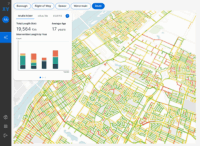How municipal asset management is evolving
Published on February 7th, 2025
Municipalities are locked in a balancing act to maintain services that residents depend on, like roads, water, and community buildings, while ensuring those services remain high-quality and cost-effective. At the same time, municipalities are facing the growing challenge of climate change and a housing crisis, both of which require significant infrastructure investments.
To meet these challenges, municipal asset management practices are evolving.
This evolution focuses on better data use, improved asset inventories, and a strong emphasis on equity, long-term value, and climate resilience.
Table of Contents
Advancements in municipal asset management
According to the Federation of Canadian Municipalities’ Municipal Asset Management Program (MAMP), over the past eight years, more than a thousand municipalities have advanced their asset management competencies, and there’s a clear push to continue improving.
Canadian municipalities increasingly recognize the importance of data-driven asset management and are overcoming barriers like limited funding and staff shortages. Prioritizing asset management helps municipalities improve organizational knowledge, decision-making, and address concerns about climate change and housing.
Through the funding made available by the FCM, over 1,600 municipalities participating in training and more than 2,000 reporting improved competencies.
The next step: Asset Investment Planning (AIP)
While the progress made through asset management training and reporting has certainly enhanced municipal capabilities, the next logical step in optimizing these practices is Asset Investment Planning (AIP). AIP takes a more strategic, long-term approach to infrastructure investment, helping municipalities make thoughtful, data-driven decisions that factor in both current needs and future challenges, including climate resilience.
A key advantage of AIP is its ability to evaluate the entire lifecycle of infrastructure investments—from planning and procurement to maintenance and eventual replacement. This comprehensive perspective ensures that decisions made today will continue to deliver value well into the future, aligning with the broader goals of sustainability and long-term resilience.
Optimizing asset management at the City of Laval
Discover how Laval is evolving its asset management practices with the support of an Asset Investment Planning solution
Learn more
Creating long-term value in municipalities
AIP offers municipalities the tools to:
Optimize investment decisions: With access to detailed asset condition data and projections for future performance, municipalities can prioritize the most urgent infrastructure projects, ensuring that every dollar spent delivers the greatest return on investment.
Align strategies across departments: AIP fosters collaboration by providing a unified view of infrastructure needs, helping different departments align their goals and investment priorities. This coordinated approach can lead to more efficient, effective decision-making.
Account for climate change: As climate-related challenges like extreme weather events become more frequent, AIP integrates climate risk assessments into the planning process. This ensures that municipalities can proactively address vulnerabilities and plan for more resilient infrastructure.
Ensure long-term sustainability: AIP moves beyond short-term fixes to consider the entire lifecycle of assets. By forecasting future needs and understanding the long-term cost implications of various investments, municipalities can avoid reactive, expensive measures and focus on sustainable, future-proof solutions.
Drive equity in infrastructure: A data-driven approach enables municipalities to assess infrastructure needs across different communities, ensuring that all residents—particularly those in underserved areas—have access to equitable, high-quality services.
Driving innovation in municipal asset management
Municipalities have a lot on their plate and are constantly facing difficult decisions. With growing pressure from climate change, population growth, a housing crisis, and aging infrastructure, it has never been more important for municipalities to adopt innovative approaches to asset management.
By adopting AIP, municipalities can take a more holistic, informed approach to infrastructure investment, ensuring that their decisions are aligned with both immediate needs and long-term goals. This framework allows municipalities to balance fiscal responsibility with the broader mission of providing reliable, resilient services to all residents, now and into the future.
Schedule a demo with Direxyon today and discover how you can set a new standard for asset management in your municipality, creating lasting value for future generations.
Let us show you how it works
Our product specialists will walk you through our proven approach to enhance your capital investment planning.

Explore resources
-
 News
NewsDIREXYON Launches GO, an AI-Powered Platform to Streamline Strategic Infrastructure Investments
Read more : DIREXYON Launches GO, an AI-Powered Platform to Streamline Strategic Infrastructure InvestmentsSelf-serve Digital Twin delivers clarity to strategic infrastructure decisions Montreal, QC, September 18, 2025 – DIREXYON Technologies today announced the launch of DIREXYON GO, a self-serve platform that simplifies and accelerates Asset Investment Planning (AIP) for municipalities and utilities. DIREXYON…
-
 E-book
E-bookTurning Wildfire Data into Smarter Investments
Read more : Turning Wildfire Data into Smarter InvestmentsYour wildfire data can do more than predict where fires may spread. It can guide the decisions that protect your grid and your communities. Wildfire threats are rising, regulations are tightening, and budgets are stretched thin. Utilities need more than…
-
 Blog
BlogWhat is Strategic Asset Management?
Read more : What is Strategic Asset Management?Strategic Asset Management is more than a buzzword. It’s a transformative shift in how municipalities and electric utilities manage infrastructure, budgets, and long-term risk. At its core, strategic asset management is about using data to make better decisions. Instead of…